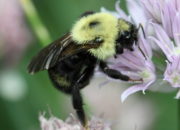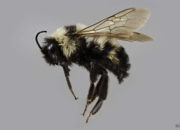Currently the most common parasitic (subgenus Psithyrus) species in the state, though far from common. Historically more widespread, now most often found in the Champlain Valley, and only regular in a few areas.
Identification: Queens are unique in the regional fauna, usually with a single yellow band on T3 and the rest of the abdomen black. Males usually have T1-T3 yellow which combined with the short, black face eliminate most other species.
Similar Species:
Fernald’s Cuckoo Bumble Bee (Bombus fernaldae): Queens yellow on T1 in addition to the yellow band on T3. Males are quite variable, but usually have some orange/red hairs on T7.
Perplexing Bumble Bee (Bombus perplexus): Males can be similar with extensive yellow on T1-T3, though in Perplexing Bumble Bees the yellow often extends further down the abdomen.
Red-belted Bumble Bee (Bombus rufocinctus): Queens can occasionally be similar, and the short face of Lemon Cuckoos is reminiscent of Red-belted. Female Red-belted have corbicula, unlike parasitic species (subgenus Psithyrus)
Global Status: Apparently Secure (G4)
Vermont Status: Imperiled (S2)
For more information, visit the following links:
Discover Life
Living Atlas Species Page
Distribution:
To see the global distribution, check out the iNaturalist account, and toggle the GBIF layer on the map.








